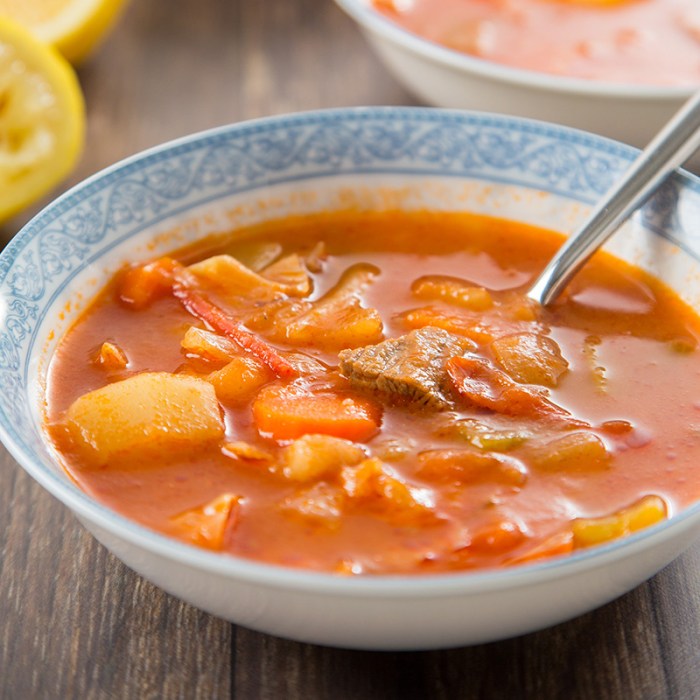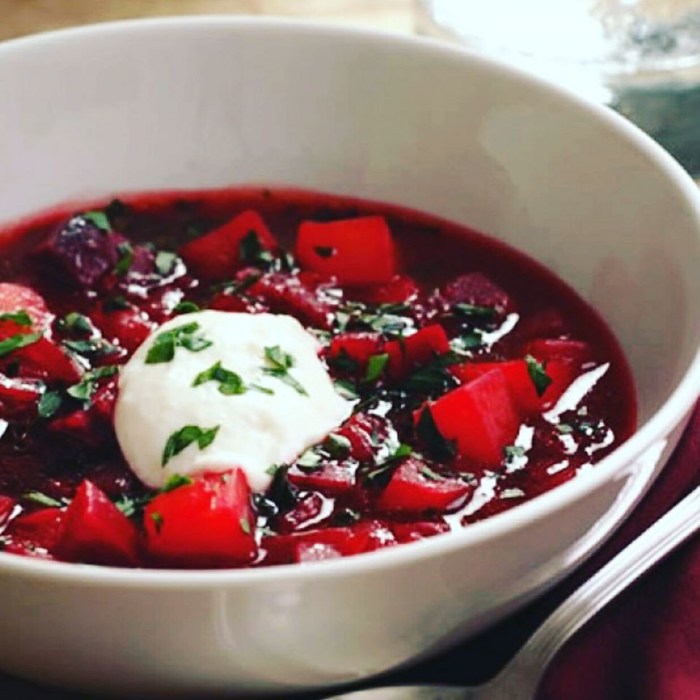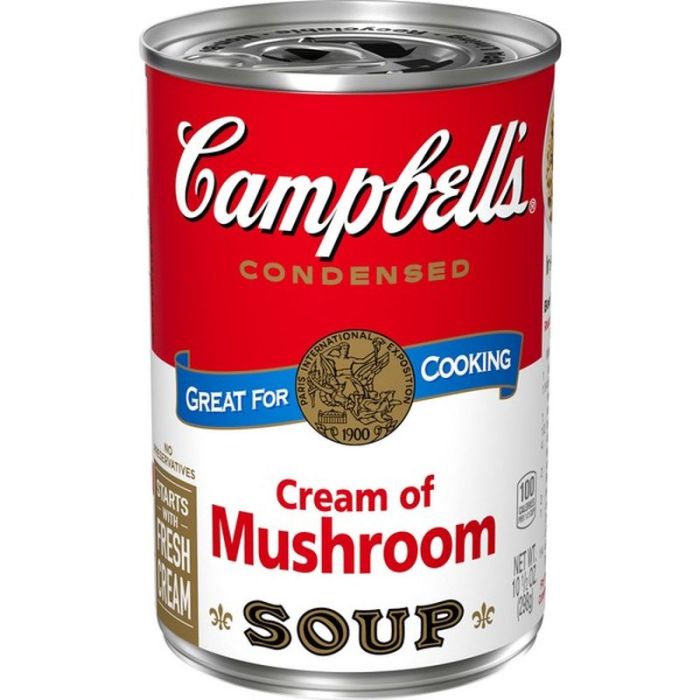Simple Borscht Soup: A Beginner’s Guide: Simple Borscht Soup Recipe
Simple borscht soup recipe – This simple borscht recipe is perfect for anyone looking to explore the vibrant world of Eastern European cuisine without getting overwhelmed. It highlights the core flavors of this classic soup while remaining accessible and adaptable to different tastes and dietary needs. Borscht, with its rich history and diverse variations, offers a comforting and flavorful experience that’s surprisingly easy to achieve.
Introduction to Simple Borscht Soup, Simple borscht soup recipe

Source: themissinglokness.com
Borscht’s appeal to beginners lies in its forgiving nature. Unlike some soups requiring precise techniques, a simple borscht allows for flexibility in ingredients and cooking times. Its history spans centuries, evolving from simple peasant fare to a celebrated dish across various cultures. Variations abound, from beetroot-centric versions to those featuring cabbage or even mushrooms, but at its heart, borscht is about creating a harmonious blend of savory and slightly sweet flavors.
Three key characteristics define a “simple” borscht: a straightforward ingredient list, minimal chopping and preparation, and a relatively short cooking time. It focuses on showcasing the natural flavors of the core ingredients rather than relying on complex techniques or a long list of spices.
Essential Ingredients and Substitutions

Source: wixstatic.com
Five essential ingredients form the foundation of a simple borscht: beets, cabbage, potatoes, carrots, and vegetable broth. Substitutions are readily available to accommodate dietary needs and ingredient availability.
| Ingredient | Substitution | Flavor Impact | Dietary Consideration |
|---|---|---|---|
| Beets | Red cabbage (for color and slight sweetness), sweet potatoes (for sweetness and earthiness) | Red cabbage offers a sharper sweetness, sweet potatoes a richer, earthier note. | Beets are naturally high in nitrates. Substitutions offer alternatives for those with sensitivities. |
| Cabbage | Spinach (for a milder flavor), kale (for a slightly bitter edge) | Spinach provides a softer, more delicate flavor; kale, a bolder, slightly more bitter taste. | Cabbage is a good source of fiber. Spinach and kale offer similar nutritional benefits. |
| Potatoes | Sweet potatoes (for sweetness), parsnips (for a slightly sweeter and earthier flavor) | Sweet potatoes add a natural sweetness; parsnips contribute a more subtle sweetness and earthiness. | Potatoes are a good source of potassium. Sweet potatoes and parsnips offer similar nutritional benefits. |
| Carrots | Turnips (for a slightly peppery flavor), butternut squash (for sweetness) | Turnips provide a mild peppery note; butternut squash contributes a significant sweetness. | Carrots are rich in beta-carotene. Turnips and butternut squash offer different nutritional profiles. |
| Vegetable Broth | Water (reduces flavor intensity), chicken broth (adds richness and umami) | Water creates a lighter broth; chicken broth adds depth and richness. | Vegetable broth is vegetarian-friendly; chicken broth is not. |
Step-by-Step Cooking Process
This simple borscht recipe emphasizes clear and concise steps for ease of preparation. Proper timing is crucial for achieving the optimal texture and flavor of each ingredient.
- Sauté diced carrots and onions until softened (approx. 5 minutes). This step develops the sweetness of the carrots and adds depth of flavor.
- Add diced beets and potatoes. Cook for another 5 minutes, allowing the beets to slightly soften. This prevents them from becoming overly mushy later.
- Stir in chopped cabbage, vegetable broth, and seasonings (salt, pepper, bay leaf). Bring to a boil, then reduce heat and simmer for 20-25 minutes, or until the vegetables are tender. Simmering ensures even cooking and allows the flavors to meld.
- Remove bay leaf before serving. Adjust seasoning as needed.
Variations and Flavor Enhancements
Simple borscht can be easily adapted to create diverse flavor profiles. These variations showcase the adaptability of the recipe while highlighting different taste experiences.
- Vegetarian Borscht: Follow the basic recipe. Enhance with fresh herbs like dill or parsley.
- Spicy Borscht: Add a pinch of red pepper flakes or a dash of hot sauce during simmering for a spicy kick.
- Creamy Borscht: Stir in a dollop of sour cream or crème fraîche before serving for a richer, creamier texture.
Three simple flavor enhancements include adding a tablespoon of lemon juice for brightness, a teaspoon of sugar to balance the earthiness of the beets, or a sprig of fresh thyme during simmering for an aromatic touch. The vegetarian borscht offers a fresh, herbaceous taste; the spicy borscht delivers a warming, fiery sensation; and the creamy borscht provides a rich, smooth texture, each significantly different in its mouthfeel and flavor profile.
Serving Suggestions and Side Dishes
Simple borscht is best served warm, ideally in a deep bowl to showcase its vibrant colors and layered textures. This enhances the overall sensory experience of enjoying the soup.
- Rye bread: The slight tanginess of rye bread complements the sweetness of the beets.
- Sourdough bread: The hearty texture of sourdough provides a satisfying contrast to the soup’s fluidity.
- Simple salad with vinaigrette: A light salad adds freshness and balances the richness of the soup.
A perfectly served bowl of borscht is visually appealing, showcasing the deep crimson hue of the beets, the vibrant green of the cabbage, and the earthy tones of the carrots and potatoes. The contrasting colors and textures create an inviting and appetizing presentation.
Nutritional Information and Benefits
A serving of simple borscht provides a good source of vitamins and minerals. The nutritional breakdown will vary based on specific ingredients and portion sizes, but generally, it is a low-calorie, nutrient-rich option.
Borscht offers several health benefits due to its rich vegetable content. Beets are a good source of nitrates, which may help improve blood flow and lower blood pressure. Cabbage is high in fiber, promoting digestive health. Carrots provide beta-carotene, an antioxidant crucial for eye health. Potatoes offer potassium, essential for maintaining healthy blood pressure.
Recipe Troubleshooting and Tips
Common mistakes in borscht preparation and solutions to prevent them are essential for a successful outcome. Proper storage is also key to maintaining the quality and flavor of leftovers.
- Overcooking the beets: Beets should be tender but not mushy. Reduce cooking time if necessary.
- Underseasoning: Taste and adjust seasoning throughout the cooking process.
- Inconsistent chopping: Evenly sized vegetables ensure even cooking.
Leftover borscht should be stored in an airtight container in the refrigerator for up to 3 days. It can also be frozen for longer storage. To adjust the recipe to suit different tastes, consider adding more or less of specific ingredients to alter the flavor profile.
Visual Representation of the Recipe
Imagine a bowl filled with a vibrant, deep reddish-purple broth. Chunks of tender beets, their deep color softened by cooking, are visible throughout, along with slivers of bright green cabbage and small pieces of orange carrots. The potatoes have softened to a creamy texture, almost melting into the broth. Before cooking, the beets are a rich, deep purple, the cabbage a crisp, light green, the carrots a bright orange, and the potatoes a pale, creamy white.
The transformation during cooking deepens the colors and softens the textures, creating a visually appealing and comforting soup.
FAQ Corner
Can I use frozen beets?
Yes, frozen beets work perfectly well. Just thaw them completely before using.
How long can I store leftover borscht?
Store leftover borscht in an airtight container in the refrigerator for up to 3-4 days.
What if my borscht is too sour?
Add a pinch of sugar or a spoonful of sour cream to balance the acidity.
Can I make this recipe vegan?
Yes, simply omit the sour cream or use a vegan alternative.
What’s the best way to thicken borscht?
The humble borscht, a vibrant symphony of beets and cabbage, offers a comforting warmth. For a more intensive, cleansing approach, consider the seven day cabbage soup diet recipe , a journey of flavor and lightness. Returning to the simpler pleasures, a bowl of borscht, brimming with its earthy goodness, remains a soulful embrace.
A cornstarch slurry (cornstarch mixed with cold water) added at the end will thicken the soup nicely.


